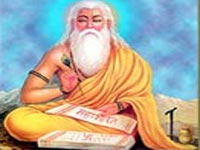What/When Is Guru Purnima?
Guru Purnima is a Santana Dharmic (Hindu) festival during which disciples express their gratitude to their Guru. The day of full moon, Purnima, in the month of Ashadh (July-August) is traditionally celebrated as Guru Purnima. Guru Purnima is a day on which the mind should shine as brightly as the full moon itself. This is possible only when the mind is filled with pure love for the Guru.
 |
Sage Ved Vyas
Guru Purnima is also known as Vyas Purnima, the day is celebrated in remembrance and reverence to sage Ved Vyas. He was the original Guru of Santana Dharma (eternal religion) and wrote many holy scriptures, including the Mahabharat. Guru Purnima is also the beginning of the Spiritual New Year.
Who Is A Guru?
Holy songs and spiritual books have the power to turn our minds towards good thoughts. However, they alone will not enable us to go forward on the path of divinity with steady steps. A spiritual aspirant, no matter how brilliant, can never attain such knowledge by his own endeavour. Therefore we have to take refuge in a Guru.
The Sanskrit root "Gu" means darkness or ignorance. "Ru" denotes the remover of that darkness. Therefore one who removes darkness of our ignorance is a Guru. A Guru will have realised the Self and will inspire and guide us on to the path of God-realization. Students also refer to their school teacher or college lecturer as a Guru. The connotation of the word Guru in this case is one who imparts temporal knowledge and is thus accordingly offered respect.
Sri Sai Das Babaji explains the difference between a Guru and Sadguru in the following quote: “A Guru is one who guides his follower in this spiritual life and helps him to progress on the Godward path. A Sadguru is one who places him face to face with God”.
Apart from guiding the aspirant on the path to God-realization, the Guru throws light on the profound meanings of the vast array of scriptural knowledge. The Guru plays a vital role in boosting the aspirant frequently, when he loses track or becomes dejected. We are able to learn what qualities such as truth, righteousness, renunciation and love mean because the Guru is a living embodiment of these. By obeying and emulating him, these qualities take root in us. Obedience to the Guru is not slavery. A true Guru will never see his disciple as his slave. He is filled with love for the disciple. He wants to see the disciple succeed, even if it means hardship for himself. The true Guru is indeed like a mother.
God and the Guru are considered to be the same. The Guru is seen as God in human form. In fact, we may say that the Guru is higher than God. It was the Guru who initiated the devotee with the mantra and direction that led to Self-realization. It is the path shown by the Guru that led the disciple to the goal. The Guru will always have a special status. The Guru's grace is also unique. If the Guru wants, he can remove the effect of God's anger and the disciple's bad karma. However, even God will not remove the sin that comes from dishonouring the Guru. Therefore the Guru should be worshipped and treated in the same manner as God, even if he is not God himself. The disciple should humbly pose questions to the Guru and please him by serving him.
The following famous verse glorifies the Guru:
Gururbrahma Gururvishnu Gururdevo Maheshwaraha,
Gurursakshaat Parambrahma Tasmai Shri Gurave Namaha.
(Guru is Brahma, Guru is Vishnu, Guru is Maheshwaraha,
Guru is verily the supreme Brahma, so, salutations to the Guru).
How Is Guru Purnima celebrated?
On this day, disciples worship the Guru with their mind, actions and speech by singing holy songs and chanting their Guru mantra, given to them by their Guru. In this, they seek the Guru’s blessings. Devotees implicitly obey his unvoiced wishes and commands. They serve him as one would serve God and praise his glory. |

